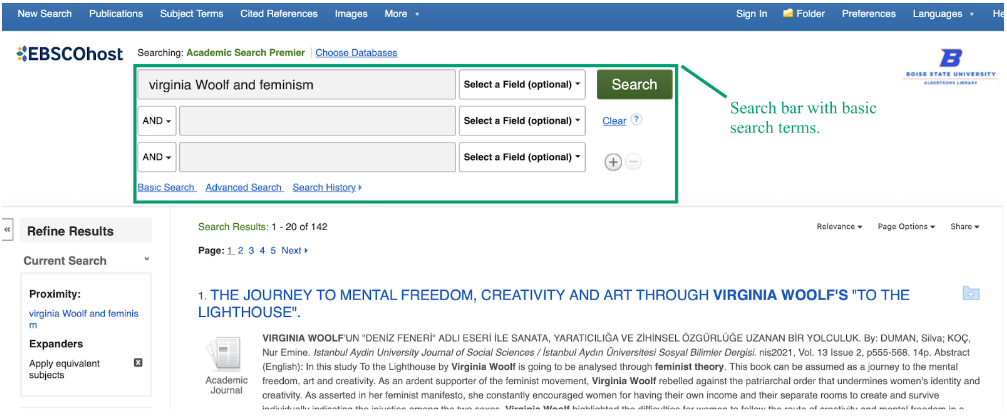Click here to download a .pdf copy of our Beginner’s Guide to Research!
Last updated: July 18, 2024
Consider keeping a printed copy to have when writing and revising your resume! If you have any additional questions, make an appointment or email us at writing@boisestate.edu!
Beginner’s Guide to Research
Most professors will require the use of academic (AKA peer-reviewed) sources for student writing. This is because these sources, written for academic audiences of specific fields, are helpful for developing your argument on many topics of interest in the academic realm, from history to biology. While popular sources like news articles also often discuss topics of interest within academic fields, peer-reviewed sources offer a depth of research and expertise that you cannot find in popular sources. Therefore, knowing how to (1) identify popular vs. academic sources, (2) differentiate between primary and secondary sources, and (3) find academic sources is a vital step in writing research. Below are definitions of the two ways scholars categorize types of sources based on when they were created (i.e. time and place) and how (i.e. methodology):
Popular vs. academic sources:
- Popular sources are publicly accessible periodicals–newspapers, magazines, and blogs–such as The Washington Post or The New Yorker. These sources are most often written for non-academic audiences, but can be helpful for finding general information and a variety of opinions on your topic.
- Academic sources, known also as peer reviewed or scholarly articles, are those that have undergone peer review before being published. Typically, these articles are written for other scholars in the field and are published in academic journals, like Feminist Studies or The American Journal of Psychology. Literature reviews, research projects, case studies, and notes from the field are common examples.
Primary vs. secondary sources:
- Primary sources are articles written by people directly involved in what they were writing about, including: News reports and photographs, diaries and novels, films and videos, speeches and autobiographies, as well as original research and statistics.
- Secondary sources, on the other hand, are second hand accounts written about a topic based on primary sources. Whether a journal article or other academic publication is considered a secondary source depends on how you use it.
How to Find Academic Sources
Finding appropriate academic sources from the hundreds of different journal publications can be daunting. Therefore, it is important to find databases–digital collections of articles–relevant to your topic to narrow your search. Albertson’s Library has access to several different databases, which can be located by clicking the “Articles and Databases” tab on the website’s homepage, and navigating to “Databases A-Z” to refine your search. Popular databases include: Academic Search Premier and Proquest Central (non-specific databases which include a wide variety of articles), JSTOR (humanities and social sciences, from literature to history), Web of Science (formal sciences and natural sciences such as biology and chemistry), and Google Scholar (a web search engine that searches scholarly literature and academic sources). If you are unable to access articles from other databases, make sure you’re signed in to Alberton’s Library through Boise State!
Performing a Database Search
Databases include many different types of sources besides academic journals, however, including book reviews and other periodicals. Using the search bar, you can limit search results to those containing specific keywords or phrases like “writing center” or “transfer theory.” Utilizing keywords in your search–names of key concepts, authors, or ideas–rather than questions is the most effective way to find articles in databases. When searching for a specific work by title, placing the title in quotation marks will ensure your search includes only results in that specific word order. In the example below, search terms including the author (“Virginia Woolf”) and subject (“feminism”) are entered into the popular database EBSCOhost:

Refining Your Search Results
Many databases have a bar on the left of the screen where you can further refine your results. For example, if you are only interested in finding complete scholarly articles, or peer-reviewed ones, you can toggle these different options to further limit your search. These options are located under the “Refine Results” bar in EBSCOhost, divided into different sections, with a display of currently selected search filters and filter options to refine your search based on your specific needs, as seen in the figure below:

Search results can also be limited by subject: If you search “Romeo and Juliet” on Academic Search Premier to find literary analysis articles for your English class, you’ll find a lot of other sources that include this search term, such as ones about theater production or ballets based on Shakespeare’s play. However, if you’re writing a literary paper on the text of the play itself, you might limit your search results to “fiction” to see only articles that discuss the play within the field of literature. Alternatively, for a theater class discussing the play, you might limit your search results to “drama.”